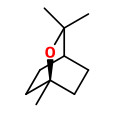Ocimum basilicum L. - Lamiaceae - basil, sweet basil, Basilikum, Basilienkraut
Annual or perenniel branched herb, 0.20-0.45m high; leaves glabrous, ovate or nearly rhomboid; flowers white or cream.
„There are many varieties of Ocimum basilicum, as well as several related species or species hybrids also called basil. The type used in Italian food is typically called sweet basil, as opposed to Thai basil (O. basilicum var. thyrsiflora), lemon basil (O. x citriodorum) and holy basil (Ocimum tenuiflorum), which are used in Asia. While most common varieties of basil are treated as annuals, some are perennial in warm, tropical climates, including holy basil and a cultivar known as 'African Blue'.“ http://en.wikipedia.org/wiki/Basil
„The European chemotype of basil is considered to have the finest flavour. Its main components are linalool (37-55% of the oil) and estragol (20-43% of the oil). The Reunion or Exotic chemotype, also widely used in the food and cosmetic industries, has a high estragol content, 86-88% of the oil. The types with eugenol or methyl cinnamate as the sole main component are well established basil chemotypes, but are regarded as inferior and are infrequently used. The occurrence of a further chemotype with high linalool and eugenol contents has been reported by several authors.“
[Nykänen, Irma. „Bestimmung der Aromazusammensetzung von in Finnland kultiviertem Basilienkraut (Ocimum basilicum L.) mittels hochauflösender Gaschromatographie-Massenspektrometrie.“ Zeitschrift für Lebensmittel-Untersuchung und Forschung 182.3 (1986), 205-211]
„More than 60 accessions of Ocimum spp. were selected for analysis based on notable differences in aroma. These plants were then harvested at full bloom and the essential oil extracted immediately from the flowering tops by hydrodistillation using modified Clevenger traps… The essential oil content ranged from 0.04 to 0.70% (v/fresh weight) within the Ocimum germplasm collection. Chemotypes high in 1,8-cineole, trans-ß-ocimene, camphor, linalool, methyl chavicol, geraniol, citral, eugenol, methyl cinnamate, methyl eugenol, ß-caryophyllene, elemene, and ß-bisabolene were identified. Accessions varied in essential oil content, and showed diversity in growth, form, flowering and pigmentation.
The major essential oil constituents found in commercial cultivars of 'Sweet Basil' included linalool and methyl chavicol, followed by eugenol and 1,8-cineole. In the red-leaved ornamental cultivars of sweet basil 'Dark Opal', methyl chavicol was only a minor constituent. Cultivars of basil yielding high percentages of linalool, eugenol, citral (neral and geranial) and ocimene were also identified.“
[Basil: a source of essential oils. Simon, J. E., Quinn, J., & Murray, R. G., Advances in new crops, 1990, 484-489]
http://www.hort.purdue.edu/newcrop/proceedings1990/v1-484.html
Commercial essential oils showed several chemotypes with main components linalool (0.1-54.5%), methylchavicol (0.3-85.8%), eugenol (0.3-75.9%), and methyleugenol (0.3-56.3%). Main components of a commercial SFE were methylchavicol (58.1%), linalool (6.6%), methyleugenol (6.5%) and eugenol (1.6%). Main components of a commercial high-pressure hexane extract were methylchavicol (29.7%), linalool (23.9%), methyleugenol (3.6%) and eugenol (2.9%).
[Blum, Carsten. „Analytik und Sensorik von Gewürzextrakten und Gewürzölen.“ (1999)] http://ediss.sub.uni-hamburg.de/volltexte/1999/57/pdf/Dr.Blum.pdf
„The perfume, pharmacy, and food industries use aromatic essential oils, extracted from the leaves and flowers of basil. Several aroma compounds can be found in chemotypes of basil such as citral, eugenol, linalool, methylchavicol, and methylcinnamate and are traded in the international essential oil market. These chemotypes are commonly known by names based on geographical origins such as Egyptian, French, European, or Reunion basil. The European type, a sweet basil, is considered to have the highest quality aroma, containing linalool and methylchavicol as the major constituents. The Egyptian basil is very similar to the European, but contains a higher percentage of methylchavicol. The Reunion type, from the Comoro Islands, and more recently from Madagascar, Thailand, and Vietnam, is characterized by high concentrations of methylchavicol. Methylcinnamate-rich basil has been commercially produced in Bulgaria, India, Guatemala, and Pakistan. A basil from Java, and Russia and North Africa is rich in eugenol.“
[Basil: a source of aroma compounds and a popular culinary and ornamental herb., Simon, J.E., Morales, M.R., Phippen, W.B., Vieira, R.F., Hao, Z., Perspectives on new crops and new uses, 1999, 499-505]
https://hort.purdue.edu/newcrop/proceedings1999/v4-499.html
 4-mercapto-4-methylpentane-2-one (fruity cassis) | 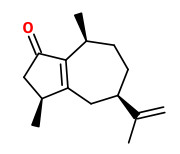 rotundone (peppery) | 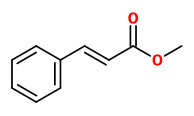 (E)-methyl cinnamate (sweet cinnamon-like) |
Omission tests with a basil model mixture showed that (Z)-3-hexenal (OAV 413000), 1,8-cineole (246000), 4-mercapto-4-methylpentane-2-one (83300), linalool (40000), 4-allyl-1,2-dimethoxybenzene (methyl eugenol, 9900) and eugenol (8900) are the most important odorants of fresh basil leaves.
[Sensory relevance of volatile organic sulfur compounds in food. Blank, Imre. ACS symposium series. Vol. 826. Washington, DC; American Chemical Society; 1999, 2002]
Rotundone (4 μg/kg, peppery) is present well above its aroma detection threshold (8 ng/L in water) and apparently important to the flavour of basil.
[Wood, C., Siebert, T. E., Parker, M., Capone, D. L., Elsey, G. M., Pollnitz, A. P., Herderich, M. J. (2008). Spice up your life–The Rotundone story. Expression of Multidisciplinary flavour science, Proceedings of the 12th Weurman Symposium.]
https://home.zhaw.ch/yere/pdf/Teil121%20-%20Expression%20of%20Multidisciplinary.pdf
„O.basilicum cv. ’Cinnamon’ can be differentiated from three other Ocimum species (O.americanum, O.×citriodorum and O.minimum) and 14 O.basilicum cultivars by the high amount of (E)-methyl-cinnamate, which is in good agreement with the data reported by Wesolowska and Jadczak (2016) [6] and the present study.“ Main compounds identified by GC-MS in the essential oil of cinnamon basil were linalool (26.5%), (E)-methyl cinnamate (24.7%), τ-cadinol (7.4%), (Z)-methyl cinnamate (3.1%), germacrene D (3.1%), β-elemene (3.0%), methyl cavicol (2.4%), α-bulnesene (2.2%), and eugenol (2.1%) e.g.
[Majdi, Chaimae, et al. „Phytochemical characterization and bioactive properties of cinnamon basil (Ocimum basilicum cv.‘Cinnamon’) and lemon basil (Ocimum× citriodorum).“ Antioxidants 9.5 (2020): 369]
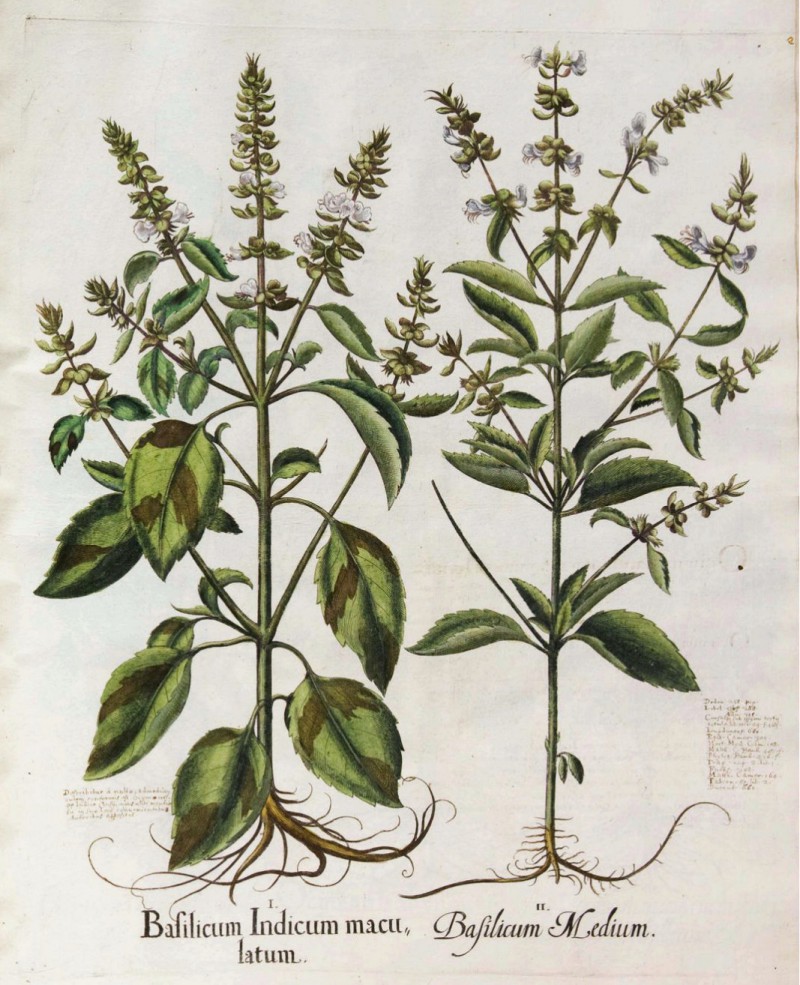
Ocimum basilicum L. as Basilicum Indicum maculatum
Bessler, Basilius, Hortus Eystettensis, vol. 2: Septimus ordo collectarum plantarum aestivalium, t. 236, fig. I (1620) [B. Besler]
http://plantgenera.org/species.php?id_species=706600
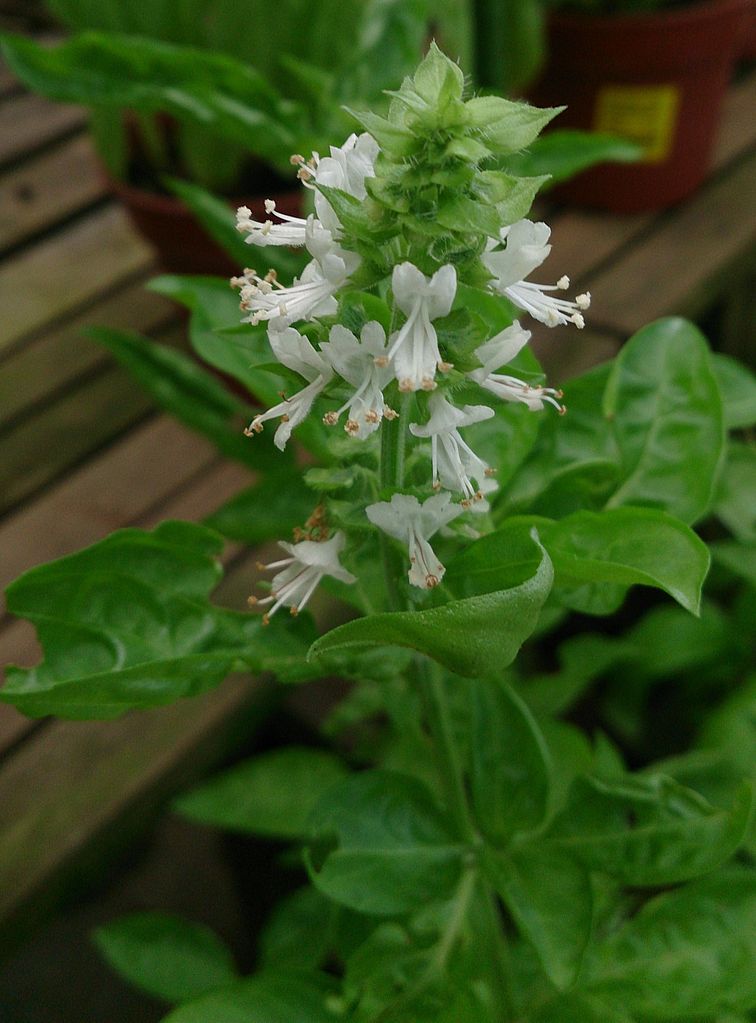
Ocimum basilicum, author Mokkie (2014)
CC BY-SA 3.0 Wikimedia Commons




